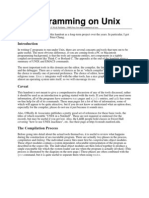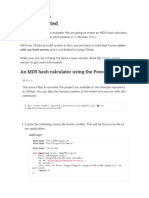Auto Tools Tutorial
Auto Tools Tutorial
Uploaded by
Abdel HadCopyright:
Available Formats
Auto Tools Tutorial
Auto Tools Tutorial
Uploaded by
Abdel HadCopyright
Available Formats
Share this document
Did you find this document useful?
Is this content inappropriate?
Copyright:
Available Formats
Auto Tools Tutorial
Auto Tools Tutorial
Uploaded by
Abdel HadCopyright:
Available Formats
Using Automake and Autoconf with C++
1 de 7
Home
Projects
http://www.openismus.com/documents/linux/automake/a...
Documents
About
Back to Documents
Using Automake and Autoconf with C++
Contents
Introduction
make and con gure
automake and autoconf
Subdirectories
Example Files
Recommended Reading
Introduction
The automake and autoconf tools can be used to manage C++
projects under Unix. They should save a lot of time compared to
writing Make les and con gure scripts manually, while ensuring
that your project is structured according to GNU standards.
However, it is di cult for beginners to get started. Hopefully, this
tutorial will provide enough information for C++ programmers who
are new to Unix to create their rst C++ projects, while gaining a
super cial understanding of what the tools are doing.
If you nd any problem with this page, we welcome feedback or
patches against the example code, which can be downloaded from
the Gitorious project page. Either send a merge request or email
murrayc@openismus.com.
make and con gure
The make tool can be used to manage multi- le projects. make
07/12/12 13:29
Using Automake and Autoconf with C++
2 de 7
http://www.openismus.com/documents/linux/automake/a...
uses the Make le le in your project folder, which lists the various
compiling and linking steps, targets, and dependencies. make is
well explained in C-Scene: Multi-File Projects and the GNU
Make Utility.
A con gure script can be used to aid cross-platform compiling. A
suitable con gure script should interpret a Make le.in le and
then create a platform-speci c Make le le. It will do this after
performing several tests to determine the characteristics of the
platform.
This allows a user to type ./con gure and then make to compile a
project on her system.
automake and autoconf
Obviously most well-written Make les and con gure scripts will look
very similar. In fact, GNU provide guidelines about what should be in
these les. Therefore, GNU created automake and autoconf to
simplify the process and ensure that the Make le and con gure
script conform to GNU standards.
Here is a brief explanation of how these tools are used. You can see
examples of the les used by these tools in the Example Files
section.
Note: These tools use the M4 programming language. aclocal adds
aclocal.m4 to your project directory, which de nes all M4 macros
which are used by the con gure script.
autoconf
autoconf looks for a le called con gure.ac (or con gure.in for
backward compatibility). It then runs the M4 macro processor to
create the con gure script.
Whenever you add a macro call to con gure.ac, aclocal should be
executed as well as autoconf, because aclocal scans con gure.ac
to nd which macros it should provide. However, nowadays one can
simply run the autoreconf utility, which takes care of those details
automatically.
07/12/12 13:29
Using Automake and Autoconf with C++
3 de 7
http://www.openismus.com/documents/linux/automake/a...
Lines which every con gure.ac should have
Every con gure.ac should have lines like the following:
AC_INIT([Hello], [0.1], [bug-report@hello.example.com], [hello], [http://hello.e
xample.com/])
AC_PREREQ([2.59])
AM_INIT_AUTOMAKE([1.10 no-define])
AC_CONFIG_HEADERS([config.h])
AC_PROG_CXX
AC_CONFIG_FILES([Makefile])
AC_OUTPUT
The AC_INIT macro initializes autoconf with information about your
project, including the project name, version number, bug-reporting
address, tarball name and the project homepage.
The AM_INIT_AUTOMAKE line adds several standard checks and
initializes automake.
AC_PROG_CXX checks for a C++ compiler. If your project uses C,
you can check for a C compiler with AC_PROG_CC.
AC_CONFIG_FILES lists the les to be generated by con gure. By
default, each le is generated from a template le of the same
name but with an .in extension appended.
AC_OUTPUT nishes con gure processing, and generates the
output les.
Using a Con g Header
The AC_CONFIG_HEADERS([con g.h]) line indicates that you will
be using a con g.h le. autoconf will then need a con g.h.in le,
which it processes to create the con g.h le. The generated header
is included by your source code to pick up the results of the various
con guration tests in the form of C preprocessor macro de nitions.
The template le con g.h.in can also be generated automatically
by the autoheader tool. autoreconf will invoke autoheader when
AC_CONFIG_HEADERS is used in con gure.ac. If multiple
con guration headers are used, autoheader will always only
generate the template for the rst one in the list.
automake
automake looks for a le called Make le.am. It then creates a
07/12/12 13:29
Using Automake and Autoconf with C++
4 de 7
http://www.openismus.com/documents/linux/automake/a...
Make le.in, based on the macros which it
by the con gure script (see above).
GNU-style projects, or not
nds. This is later used
Because automake tries to make a GNU-style project by default, it
will add a COPYING le and complain if some other necessary
informative text les are missing. For the moment, you can create
blank les with the following command, and ll them in later:
touch NEWS README AUTHORS ChangeLog
If you do not want these GNU-style les, then you could add the
'foreign' argument to your AM_INIT_AUTOMAKE call in con gure.ac
instead:
AM_INIT_AUTOMAKE([1.10 no-define foreign])
Telling automake about your source les
Use lines like the following to name your program and list its source
les:
bin_PROGRAMS = hello
hello_SOURCES = hello.h hello.cc main.cc
Note that the name of the variable hello_SOURCES is pre xed with
the name of the target de ned by the assignment to
bin_PROGRAMS. This is a common practice with autoconf and
automake. Similarly, the pre x of the bin_PROGRAMS variable also
has a meaning: It refers to the prede ned variable bindir, which
de nes the installation directory for user-visible executable les.
Thus, the rst assignment instructs automake to generate build
rules for an executable target le called "hello", which will be
installed into the directory named by bindir on execution of make
install. The second assignment instructs Automake to generate rules
for building the "hello" target from the three C++ source les listed.
The Whole Process
Assuming that you have written appropriate Make le.am and
con gure.ac les (there are examples below), you should be able to
build your project by entering the following commands:
07/12/12 13:29
Using Automake and Autoconf with C++
5 de 7
http://www.openismus.com/documents/linux/automake/a...
'touch NEWS README AUTHORS ChangeLog'
'autoreconf --force --install' - runs aclocal, autoconf,
autoheader and automake in the right order to create
con g.h.in, Make le.in, con gure and a number of auxiliary
les
'./con gure' - creates Make le from Make le.in and con g.h
from con g.h.in
'make'
Just repeat the last three steps to completely recon gure the
project. Most projects kept in version control have an autogen.sh
script that runs everything up to the con gure step. This is done to
provide a standard means for generating the build les from
scratch, as generated les should never be put under version
control. Release tarballs ship with pre-generated con gure and
Make le.in les, so that the installer does not need to have
autoconf or automake installed.
Subdirectories
Project les should, of course, be organised in subdirectories.
Ideally, all of the source les should be in a directory called 'src' in
the project directory, with all of the other les (such as Make les,
con gure scripts, and READMEs) separate at the top. Projects which
have several levels of directories are called 'deep' projects. The
necessary steps are listed here, but you should look at the Example
Files section to see them in context.
Example Files
Here are some example con gure.ac and Make le.am les. They
are su cient to manage a C++ project which only uses the C++
Standard Library.
The example uses non-recursive Make le rules, which makes
things simpler and allows faster builds. Many existing projects use
recursive make, with a Make le.am in each subdirectory. That
generates a small non-installed library in each directory, which must
be linked together (in the right order) into a binary. This is one of the
main problems with recursive make.
07/12/12 13:29
Using Automake and Autoconf with C++
6 de 7
http://www.openismus.com/documents/linux/automake/a...
See the automake and autoconf manuals in the recommended
reading section for information on the macros and variable names
used in these les.
These examples are for a 'deep' project with the following structure:
helloworld_cc
autogen.sh
configure.ac
Makefile.am
src
helloworld.h
helloworld.cc
main.cc
foo les
foo.h
foo.cc
con gure.ac
AC_INIT([Helloworld C++], [0.5], [bug-report@hello.example.com],
[helloworld_cc], [http://hello.example.com/])
AC_PREREQ([2.59])
AM_INIT_AUTOMAKE([1.10 -Wall no-define])
AC_CONFIG_HEADERS([config.h])
AC_PROG_CXX
AC_CONFIG_FILES([Makefile])
AC_OUTPUT
Make le.am
AUTOMAKE_OPTIONS = subdir-objects
ACLOCAL_AMFLAGS = ${ACLOCAL_FLAGS}
bin_PROGRAMS = hello
hello_SOURCES = src/hello.h src/hello.cc src/main.cc \
src/foo/foo.h src/foo/foo.cc
dist_noinst_SCRIPTS = autogen.sh
You may download the helloworld_cc-0.5.tar.gz tar archive of the
simple example project, or browse through the source at Gitorious.
Recommended Reading
Building C/C++ libraries with automake and autoconf
Using C/C++ libraries with automake and autoconf
C-Scene: Multi-File Projects and the GNU Make Utility
Autotools Mythbuster
GNU autoconf manual
07/12/12 13:29
Using Automake and Autoconf with C++
7 de 7
http://www.openismus.com/documents/linux/automake/a...
GNU automake manual
Using GNU Autotools
Autotools: A practitioner's guide to Autoconf, Automake
and Libtool
Translations
We know of the following translations of this article:
Ukranian
Copyright Murray Cumming, Openismus GmbH.
This work is licensed under a Creative Commons License.
Openismus | Impressum
07/12/12 13:29
You might also like
- Performance With LaravelDocument217 pagesPerformance With LaravelAlexcsandruNo ratings yet
- Tesla (TSLA) WARN Notice in California May 13, 2024Document16 pagesTesla (TSLA) WARN Notice in California May 13, 2024CNBC.comNo ratings yet
- Amdocs OSS 8.1 Suite Platform RequirementsDocument33 pagesAmdocs OSS 8.1 Suite Platform RequirementsAngel CuevasNo ratings yet
- Programming On Stanford)Document17 pagesProgramming On Stanford)Rakesh SinghNo ratings yet
- C MaterialDocument47 pagesC MaterialdeeuGirlNo ratings yet
- Makefile TutorialDocument4 pagesMakefile TutorialcrsarinNo ratings yet
- CS Students Linux User's Guide: Writing A MakefileDocument7 pagesCS Students Linux User's Guide: Writing A MakefilewildgbirdNo ratings yet
- Learning CmakeDocument45 pagesLearning Cmakexieyubo100% (6)
- Lab 04Document1 pageLab 04Luis Fernando Soto UgaldiNo ratings yet
- C Compilation ProcessDocument9 pagesC Compilation ProcessSourav Ba Ronnie100% (1)
- Compiling Software From SourceDocument12 pagesCompiling Software From SourcebinzbinzNo ratings yet
- A Simple Makefile TutorialDocument4 pagesA Simple Makefile TutorialNarendran NareshNo ratings yet
- 07 C ProgrammingDocument8 pages07 C ProgrammingSubramanian VenkatesanNo ratings yet
- Programming On UnixDocument17 pagesProgramming On Unixpolymathswot1No ratings yet
- Getting Started - Conan 1.37.2 DocumentationDocument12 pagesGetting Started - Conan 1.37.2 DocumentationAhmed MohamedNo ratings yet
- Functions in CDocument23 pagesFunctions in Cgdayanand4uNo ratings yet
- CI - CD of Flask Application Using AWS CodeBuild, CodeDeploy and CodePipelineDocument76 pagesCI - CD of Flask Application Using AWS CodeBuild, CodeDeploy and CodePipelineSidney O. EbotNo ratings yet
- Docker Lab ENG v3 020424Document10 pagesDocker Lab ENG v3 020424temporal034No ratings yet
- Makefile TutorialDocument22 pagesMakefile TutorialAmbuj SaxenaNo ratings yet
- Unit IIIDocument3 pagesUnit IIIUmesh GadhaveNo ratings yet
- VC++ BookDocument92 pagesVC++ BookManeesh BradiyilNo ratings yet
- A Simple Makefile TutorialDocument3 pagesA Simple Makefile TutorialMedhat SaberNo ratings yet
- Docker For Local Web Development, Part 1 - A Basic LEMP StackDocument30 pagesDocker For Local Web Development, Part 1 - A Basic LEMP StackShirouitNo ratings yet
- Antlr C Sharp Code Generation Using VisualDocument8 pagesAntlr C Sharp Code Generation Using Visualyailsk8No ratings yet
- Objective C NotesDocument13 pagesObjective C NotesSai ChanduNo ratings yet
- Makefile Brief TutorialDocument10 pagesMakefile Brief TutorialOmkar J GoulayNo ratings yet
- Ns-3 Application Note: Why Don't Those #@ (%! & Libraries Work?Document17 pagesNs-3 Application Note: Why Don't Those #@ (%! & Libraries Work?Ahmad JaamayNo ratings yet
- C Programming Tools: 2.1 Manual SectionsDocument9 pagesC Programming Tools: 2.1 Manual SectionsAbhishekLolageNo ratings yet
- Practical Makefiles, by ExampleDocument11 pagesPractical Makefiles, by Examplepinakin4uNo ratings yet
- ModelSim Tutorial - Getting StartedDocument18 pagesModelSim Tutorial - Getting StartedĐoàn Tiến ĐạtNo ratings yet
- Getting Started With ComponentsDocument20 pagesGetting Started With ComponentseshamuNo ratings yet
- C Track: Compiling C Programs.: The Different Kinds of FilesDocument4 pagesC Track: Compiling C Programs.: The Different Kinds of FilesHappa1No ratings yet
- Programming-An-Overview/4.html: HistoryDocument17 pagesProgramming-An-Overview/4.html: Historysukanyas111No ratings yet
- JSWRTS Part2 WebpackDocument7 pagesJSWRTS Part2 WebpackInfo DataNo ratings yet
- Lab 2 C Programming On Linux, Mac OS X Course: Operating SystemsDocument13 pagesLab 2 C Programming On Linux, Mac OS X Course: Operating SystemsSao Hỏa SehnsuchtNo ratings yet
- Amos C++ Lab 3Document13 pagesAmos C++ Lab 3zyd.13.officialNo ratings yet
- How To Build Applications With OpenCV Inside The Microsoft Visual Studio - OpenCV v2.4Document8 pagesHow To Build Applications With OpenCV Inside The Microsoft Visual Studio - OpenCV v2.4Kartik ChivukulaNo ratings yet
- AutotoolsDocument8 pagesAutotoolspostscriptNo ratings yet
- Practical Cycle of C ProgramDocument2 pagesPractical Cycle of C ProgramAsad AltafNo ratings yet
- Language Specification & Compiler Construction: HandoutsDocument18 pagesLanguage Specification & Compiler Construction: HandoutsArogundade Oluwasanmi RichardNo ratings yet
- EGR424 S'12 Project #1Document3 pagesEGR424 S'12 Project #1gin1119No ratings yet
- GCC TutorialDocument4 pagesGCC TutorialSakib FarhadNo ratings yet
- Docker-compose-101-notesDocument11 pagesDocker-compose-101-notesdevopspracticeprajeetNo ratings yet
- DmallocDocument60 pagesDmallocbojke2000No ratings yet
- MakeDocument158 pagesMakeMiki PerezNo ratings yet
- Contributing To Open Source ProjectsDocument8 pagesContributing To Open Source ProjectsZachary LloydNo ratings yet
- LinkedList Project Instructions 20191104aDocument8 pagesLinkedList Project Instructions 20191104aGrayhat AnonymousNo ratings yet
- Tutorial - Setting Up A GCC Development Environment For ARM Cortex (Windows)Document5 pagesTutorial - Setting Up A GCC Development Environment For ARM Cortex (Windows)whirlexNo ratings yet
- Castalia - InstallationDocument11 pagesCastalia - InstallationkhadijehnooriNo ratings yet
- The Kubebuilder BookDocument221 pagesThe Kubebuilder BookAlex CastilioNo ratings yet
- Gen10 PreworkDocument297 pagesGen10 PreworkGeorge YooNo ratings yet
- O - O P V B: Bject Riented Rogramming With Isual AsicDocument20 pagesO - O P V B: Bject Riented Rogramming With Isual AsicBayu Aji SNo ratings yet
- Kernel Configuration, Compilation and InstallationDocument57 pagesKernel Configuration, Compilation and InstallationkrishnaveniakshayaniNo ratings yet
- A Simple Makefile TutorialDocument3 pagesA Simple Makefile TutorialtotoNo ratings yet
- Notes2Document47 pagesNotes2shubhpsNo ratings yet
- How To Work With Code Blocks - TutorialDocument17 pagesHow To Work With Code Blocks - TutorialSuraz Verma100% (1)
- Configure HowtoDocument5 pagesConfigure HowtoCaio LoureiroNo ratings yet
- The Mysql C Api: Y Provides A Client Library WrittenDocument53 pagesThe Mysql C Api: Y Provides A Client Library WrittenVara Prasad SurviNo ratings yet
- C# For Beginners: An Introduction to C# Programming with Tutorials and Hands-On ExamplesFrom EverandC# For Beginners: An Introduction to C# Programming with Tutorials and Hands-On ExamplesRating: 5 out of 5 stars5/5 (1)
- OOP Micro-Project ReportDocument36 pagesOOP Micro-Project ReportAnurag Pawar100% (2)
- Apex WorkbookDocument87 pagesApex WorkbookAjay TyagiNo ratings yet
- Snowflakes Beginner To Intermediate Path UpdatedDocument4 pagesSnowflakes Beginner To Intermediate Path UpdatedharinithinNo ratings yet
- CMR College of Engineering & Technology Kandlakoya (V), Medchal Road, HyderabadDocument66 pagesCMR College of Engineering & Technology Kandlakoya (V), Medchal Road, HyderabadRohit MantripragadaNo ratings yet
- P5 Library P5Document22 pagesP5 Library P5SHRADDHA SINGHNo ratings yet
- Data TypesDocument24 pagesData Typesmilbert bechaydaNo ratings yet
- Oracle Database 11g: Develop PL/SQL Program Units Release 2: DurationDocument4 pagesOracle Database 11g: Develop PL/SQL Program Units Release 2: DurationKrish MalhotraNo ratings yet
- SchedularDocument2 pagesSchedularabdoahmad426.rrNo ratings yet
- A121 7CCS01Document2 pagesA121 7CCS01manoj phadtare100% (1)
- Major Project Report For B.Tech. BE Engineering Computer ScienceDocument7 pagesMajor Project Report For B.Tech. BE Engineering Computer Scienceankur_niitNo ratings yet
- Ziwewe Nyasha Systems Developer CVDocument6 pagesZiwewe Nyasha Systems Developer CVNyasha D ZiweweNo ratings yet
- Gpu, Cuda and PycudaDocument11 pagesGpu, Cuda and PycudaHugo ContrerasNo ratings yet
- Word ProDocument1 pageWord Proday6 favorite, loveNo ratings yet
- MAD EXP6 ProgDocument5 pagesMAD EXP6 Prog[CO - 174] Shubham MouryaNo ratings yet
- Text and File ProcessingDocument52 pagesText and File ProcessingZgjimNo ratings yet
- Seven Knight Hero Tier List 6Document31 pagesSeven Knight Hero Tier List 6Muhammad FaisalNo ratings yet
- Muzammil Khan Resume UDDocument5 pagesMuzammil Khan Resume UDMuzammil KhanNo ratings yet
- INS Form 1 September 2021 Revision 4: Page 1 of ?Document9 pagesINS Form 1 September 2021 Revision 4: Page 1 of ?EdmonNo ratings yet
- Project Life CycleDocument3 pagesProject Life CycleRajeshkr2768No ratings yet
- JS5 ClassNotesDocument10 pagesJS5 ClassNotesAyush ParateNo ratings yet
- Developing ModelReview PluginsDocument5 pagesDeveloping ModelReview PluginsRAUL VARGAS CHNo ratings yet
- 1.c Note ComplethjgjgDocument4 pages1.c Note ComplethjgjgSanjib BaglariNo ratings yet
- Sri Krishna Arts & Science College: I B. Com It ADocument19 pagesSri Krishna Arts & Science College: I B. Com It ARijo Jackson TomNo ratings yet
- Programming ConceptsDocument38 pagesProgramming ConceptsCarLos Babaran100% (1)
- Programming Assignment #3: Huge Fibonacci: COP 3502, Spring 2017Document10 pagesProgramming Assignment #3: Huge Fibonacci: COP 3502, Spring 2017Andrew CooperNo ratings yet
- SRS of Students Result Management SystemDocument6 pagesSRS of Students Result Management SystemABHIJITH DAS0% (1)
- ECSE429 Assignment 2Document3 pagesECSE429 Assignment 21mysterious.iamNo ratings yet

























































































